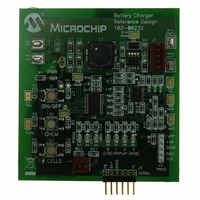MCP1631RD-MCC2 Microchip Technology, MCP1631RD-MCC2 Datasheet - Page 44

MCP1631RD-MCC2
Manufacturer Part Number
MCP1631RD-MCC2
Description
REFERENCE DESIGN MCP1631HV
Manufacturer
Microchip Technology
Datasheets
1.MCP1631VHVT-330EST.pdf
(34 pages)
2.MCP1631HV-330EST.pdf
(54 pages)
3.MCP1631RD-MCC2.pdf
(20 pages)
4.MCP1631RD-MCC2.pdf
(328 pages)
Specifications of MCP1631RD-MCC2
Main Purpose
Power Management, Battery Charger
Embedded
Yes, MCU, 8-Bit
Utilized Ic / Part
MCP1631HV, PIC16F883
Primary Attributes
1 ~ 2 Cell- Li-Ion, 1 ~ 5 Cell- NiCd/NiMH, 1 ~ 2 1W LEDs
Secondary Attributes
Status LEDs
Silicon Manufacturer
Microchip
Application Sub Type
Battery Charger
Kit Application Type
Power Management - Battery
Silicon Core Number
MCP1631HV, PIC16F883
Kit Contents
Board
Lead Free Status / RoHS Status
Lead free / RoHS Compliant
Lead Free Status / RoHS Status
Lead free / RoHS Compliant
MCP1631HV Multi-Chemistry Battery Charger Reference Design
C.6
DS51791A-page 40
LAB EXERCISES
1. Startup the mikroC
2. Startup MPLAB and load the
C.6.1
1. In the mikroC
2. Double click on the
3. Scroll through the header file and locate “#define LION_SUPPORT”.
4. Scroll through the header file and locate “#define NIMH_SUPPORT”.
5. Scroll through the header file and locate “#define LED_DRIVER_SUPPORT”.
6. Scroll down to the “#IF (LION_SUPPORT == ENABLED) section of the header
7. Set the LI_ION_CONDITION_CURRENT to 200 mAh. (Conditioning mode
8. Set the LI_ION_CONDITION_VOLTAGE to 3000 mV. (Transition point from
9. Set the LI_ION_CHARGE_CURRENT to 1200 mAh. (CC mode current)
10. Set the LI_ION_CHARGE_TERMINATION_CURRENT to 84 mAh. (0.07C –
11. Save the file (File | Save).
12. Compile (Project | Build).
13. Open MPLAB and load the workspace if it is not already loaded. (File | Open
14. Import the new “MCP1631HVBuckBoostBatteryChargerReferenceDesign.hex”
15. Download the file (Debugger | Program) and reset the processor (Debugger |
16. Run the new program (Debugger | Run).
17. Calibrate the Li-Ion Termination Voltage.
18. Disconnect and turn on the power supply and set the variable output voltage to
19. Connect the fixed 12V supply (+) lead to the input connector (+) pin J1-1.
20. Connect the fixed 12V supply (-) lead to the input connector (-) pin J1-2.
21. Connect the 4.200V variable supply (+) lead to the battery connector (+) pin J2-1.
22. Connect the 4.200V variable supply (-) lead to the battery connector (-) pin J2-5.
23. Turn on the power supply.
“MCP1631HVBuckBoostBatteryChargerReferenceDesign.ppc” if it does not
load up automatically.
“MCP1631HVBuckBoostBatteryChargerReferenceDesign.mcw” workspace if it
does not start up automatically.
the ‘.H’ file list.
“MULTICHEMISTRY_REF_DESIGN_BOARD_102_00232.H” file to open it.
Set it to “ENABLED”.
Set it to “DISABLED”.
Set it to “DISABLED”.
file. The section contains Lithium Ion specific parameters. Note that there is a
Nickel Metal Hydride and LED Driver section also.
current)
Conditioning to CC mode)
Termination Current for CV mode)
Workspace)
Directory}\MCP1631HVBuckBoostBatteryChargerReferenceDesign.mcw
file. (File | Import)
Reset | Processor Reset).
4.200V. Turn off the power supply.
Li-Ion Only Exercise (single cell, 1200 mAh pack)
{Source
™
“Project Summary” frame, click on the “H files” branch to expand
TM
compiler and load the
© 2009 Microchip Technology Inc.













